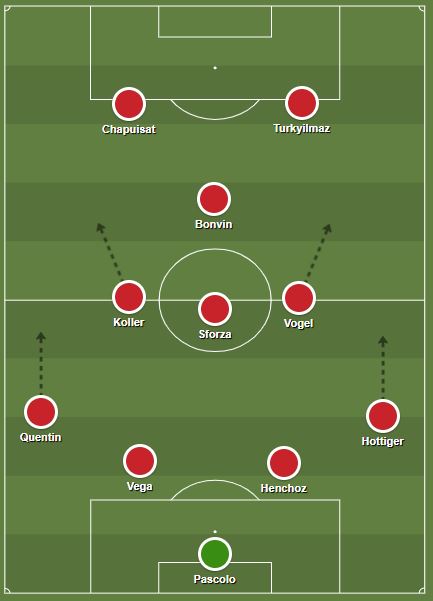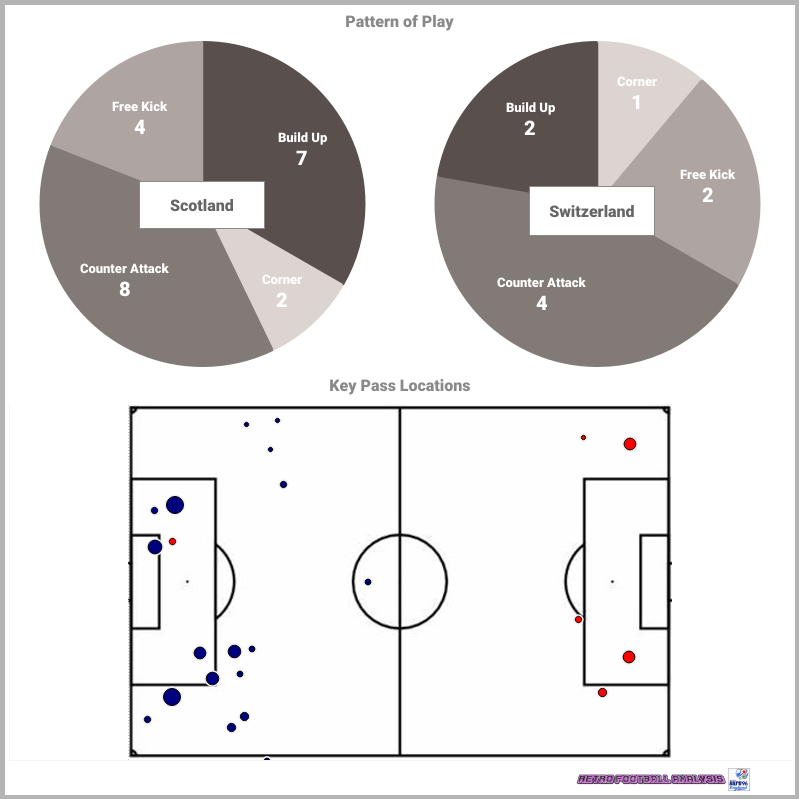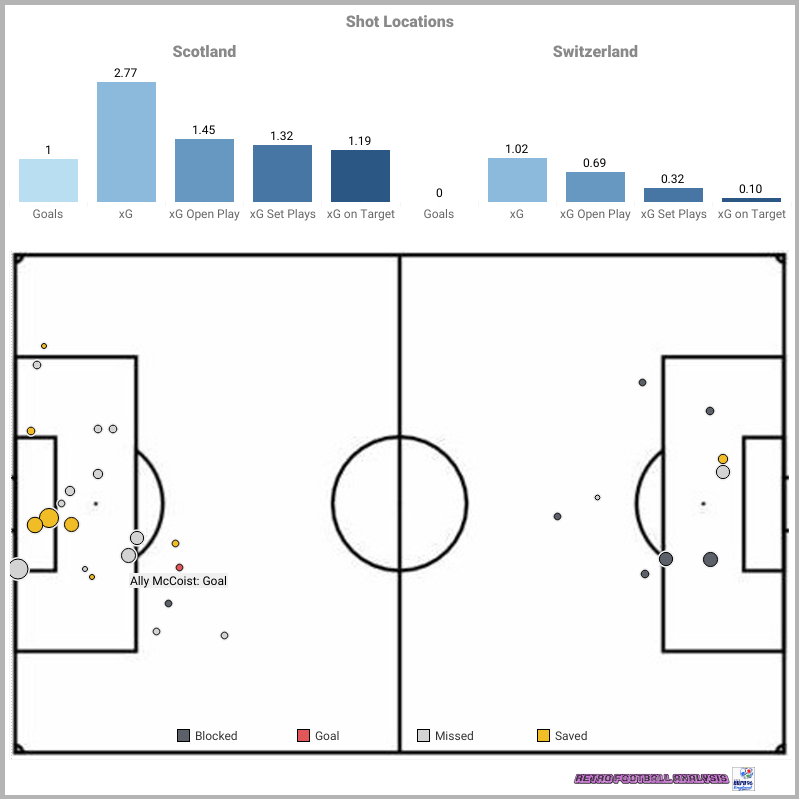Switzerland utilized a 4312 system, which would fall back into a 4132 when defending. The Swiss were once again defensively compact, as they forced the ball into wide areas, but used their central positioning to transition forward through the strikers and midfield support play.
Vogel and Koller covered the inside channels, both in and out of possession, with Sforza and Bonvin working in central areas to build attacks and find the strikers with forward passes.
Chapuisat & Turkyilmaz worked well in dividing their responsibilities as a partnership, both of which comfortable pulling wide to create as well as attacking centrally.
Quentin and Hottiger were given more license to attack the flanks in this game, especially so as they chased the game in the second half, both of which looking to get to the end line to play crosses into the box.
Switzerland Starting X1

Scotland set up in 352 formation, with the wing backs taking up a far more attacking role to anything we had witnessed in the previous two games.
Collins worked in the inside left channel to combine with McKinlay, but also to attack through central dribbles and get shots at goal. McAllister linked the game well across the entire field, almost playing with a free role, where as McCall served to protect the central areas and break up play if required.
Burley would work on the right hand side with Durie, taking up a number of advanced positions in which to deliver the ball into the box from deep.
McCoist and Durie partnership worked well, with Durie dropping to link play and McCoist working on the high line to attack the spaces inside the box.
Scotland Starting X1

Scotland set up in 352 formation, with the wing backs taking up a far more attacking role to anything we had witnessed in the previous two games.
Collins worked in the inside left channel to combine with McKinlay, but also to attack through central dribbles and get shots at goal. McAllister linked the game well across the entire field, almost playing with a free role, where as McCall served to protect the central areas and break up play if required.
Burley would work on the right hand side with Durie, taking up a number of advanced positions in which to deliver the ball into the box from deep.
McCoist and Durie partnership worked well, with Durie dropping to link play and McCoist working on the high line to attack the spaces inside the box.
WHAT DO THE NUMBERS TELL US?

Value of Chances
xG Timeline:
Scotland made an almost perfect start to this game, with two big chances (opta definition: A situation where a player should reasonably be expected to score, usually in a one on one scenario or from very close range when the ball has a clear path to goal) in the opening 5 minutes of play. From here they continue on an impressive pursuit for a win, consistently attacking their opponents without letting up.
Switzerland had it all to play for in this match and simply didn’t show up. Despite having the higher quality players, and in Turkyilmaz one of the players of the group so far, they simply weren’t able to fashion enough chances to establish and sustained period of dominance in the match.
Chance Quality:
As mentioned Scotland would create two big chances in the match, both of which hit the target but weren’t able to convert them into a goal, therefore the 1-0 win falls below what their attacking dominance would suggest (1 goal from 2.74 expected goals). While Scotland would pepper the Swiss goal with attacks, plenty of them were valued in the double digit xG range, so there was plenty of substance to their chance creation.
Switzerland wouldn’t create any big chances, nor would they hit anything that genuinely troubled Andy Goram in the Scotland goal. The more damning statistic is that their best two chances after Scotland’s goal were almost 30 minutes apart, suggesting that Switzerland’s fight back never even got started.
Type of Chances Created

Looking at Scotland’s key pass map its almost hard to recognize them as the same team that competed in the opening two games. Almost every attack is created within the final third with many of their left side key passes causing Switzerland significant problems. The higher positioning of Scotland’s wing backs enabled them to advance their central players (midfielders and strikers) into Switzerlands box, and through their use of crosses (6 key passes in total coming from crosses) they would foster a far greater attacking threat throughout the match. The continued to be defensively solid in the game, which allowed them to create counter attacking opportunities, however it was the license Coach Craig Brown had given his wide players (McKinlay & Burley) that allowed Scotland to really do damage in the opponents half.
Switzerland would only create 4 attacks from open play in the match, all of which coming from the target zones (edge of the 18 yard box) that had served them so well in the earlier two games. On this occasion however they were unable to generate anything positive from these areas, with only 1 of the 4 open play key passes resulting in a shot on goal.
Where Chances are Created

Once we peel back the layers further to each teams attack play, the shot outcomes give us a new perspective on how each team performed.
Switzerlands attack play fell way below the level they are capable of, however when we study this graph we see 6 of their 9 attacks were blocked on route to goal. Ultimately this shows us how strong Scotland were at the back, and on another day these shots could have resulted in a different outcome had they not faced the same level of pressure. Of course they would have liked to fashion more chances overall, but from the ones they did create we have to commend Scotland on a good defensive display.
What I found to be most interesting was breaking down Scotland’s attack play. While they will be happy with the amount of chances they created inside the box, 15 in total from an overall 21 attacks, they did only return 5 of these on target. If we drill down deeper we see that 9 of these 15 box attacks took place inside the golden zone (within the central portion of the 18 yard box) and from these only 3 hit the target. While this was a deserved victory for Scotland it was the lack of goals from the game that would see them exit the tournament, as a multiple goal victory would have saw them overtake Holland into second place.
Who Created Chances
Switzerland’s best statistical attacker in the match was, once again, Kubilay Turkyilmaz. He would be part of 3 attacks overall in the match, one of which he would hit on target and return an overall xG of 0.16.
Scotland’s best statistical attacker is the striker who would play the least amount of minutes at the tournament, Ally McCoist. He will be disappointed not to have added more goals to his tally today given he had two Big Chances that the keeper saved from him, however he would return 6 attacks overall, 3 of which were on target, 1 of which was a goal, and an xG rating of 0.98 (almost a third of Scotland’s team xG).
Match Predictor
Using our very own Retro Football Analysis Match Simulator, we use the probability rating of each attack to calculate the odds of the matches outcome. Here are the results we got back.

Our verdict:
Little surprise in the outcomes of this one. Scotland will be bitterly disappointed to exit the tournament on account of a lack of goals from this match, especially given their change in fortunes in the final third. With that said the Swiss too will look at this as a massive opportunity wasted, as the game simply didn’t go as they would have planned, or indeed had live up to the potential that they have in their side. The Holland result at Wembley would have come as a big shock to both sides, but Kluivert’s late goal would see them through as group runners up.


